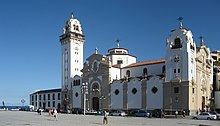Basilica of Candelaria
| Basilica of Our Lady of Candelaria | |
|---|---|
| Basílica Nuestra Señora de Candelaria | |

Basilica of Our Lady of Candelaria
|
|
| Basic information | |
| Location | Candelaria, Tenerife, Spain. |
| Geographic coordinates | 28°21′05″N 16°22′11″W / 28.35139°N 16.36972°WCoordinates: 28°21′05″N 16°22′11″W / 28.35139°N 16.36972°W |
| Affiliation | Roman Catholic |
| District | Diocese of San Cristóbal de La Laguna |
| Province | Archdiocese of Seville |
| Year consecrated | 1959 |
| Ecclesiastical or organizational status | Minor basilica, Royal Marian shrine and conventual church |
| Website | basilicadecandelaria |
| Architectural description | |
| Architect(s) | José Enrique Marrero Regalado |
| Architectural style | Neoclassicism |
| Groundbreaking | 1949 |
| Completed | 1959 |
| Specifications | |
| Direction of façade | West |
| Capacity | 5000 |
The Basilica of the Royal Marian Shrine of Our Lady of Candelaria (Spanish: Basílica y Real Santuario Mariano de Nuestra Señora de la Candelaria or simply Basílica de la Candelaria) is a Roman Catholic minor basilica, the first Marian shrine of the Canary Islands, located in the municipality and city of Candelaria on the island of Tenerife (Canary Islands, Spain). It is located some 20 km (12 mi) south of the island's capital, Santa Cruz de Tenerife.
The basilica is dedicated to the Virgin of Candelaria (Patron of the Canary Islands). Designed by architect José Enrique Marrero Regalado, it is listed as a Site of cultural interest by the Government of the Canary Islands.
The Virgin of Candelaria is a black Madonna.
In 1390, Candelaria was a solitary place frequented by guanches herders of the menceyato de Güímar (pre-Hispanic kingdom). One evening, two natives leading their cattle, saw some goats refusing to come to the mouth of the ravine; they sent forward one of them thinking that there were people who wanted to steal them and they found, on a rock, the statue of the Virgin of Candelaria (later declared principal patron of the Canary Islands).
The statue was found in a beach near to Candelaria. It was initially taken to the cave of Chinguaro, which was the palace of the king (mencey) of Güímar. Later the Guanches moved her to the cave of Achbinico in Candelaria, and from then on it was venerated there. At first the Guanches identified it with their goddess Chaxiraxi (the mother of the gods), but later the Christian conquerors identified it as the statue of the Virgin Mary. Shortly after, a chapel was built. This cave was also used as a cemetery for Christian devotees of the Virgin. In 1596, king Philip III was declared protector of the Virgin of Candelaria. After ascending the throne, the Spanish monarch gave the title of "Royal" to the sanctuary of the Candelaria. Therefore, it is also the first sanctuary in the Canary Islands to have received that title.
...
Wikipedia
